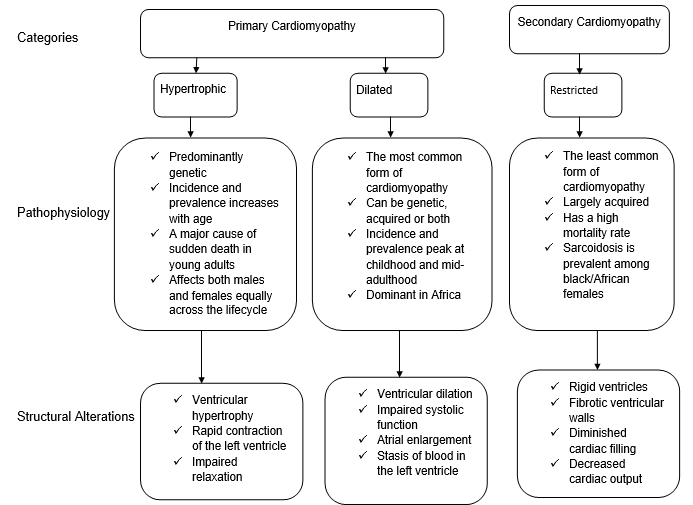As people grow old by age, so do their bodily organs which the heart is part of. Cardiomyopathy is one condition that results from the degeneration of the heart tissue. Cardiomyopathy is divided into primary and secondary cardiomyopathy. Primary cardiomyopathies are limited to the heart muscle, and can be genetic, acquired, or both, while secondary cardiomyopathies are linked to other underlying medical conditions. While some literature denotes that hypertrophic cardiomyopathy is the prevalent one among the elderly, others suggest that dilated is the most prevalent one among the elderly, yet others indicate restrictive cardiomyopathy. This paper discusses all those cardiomyopathies linked to old age.
Cardiomyopathy refers to the diseases of the heart muscle. The latest definition in 2006, denotes that cardiomyopathy is “a heterogeneous group of diseases of the myocardium associated with mechanical and/or electrical dysfunction that usually, but not invariably exhibit inappropriate ventricular hypertrophy or dilation” (Aminoff, 2008, p. 82). This muscle either becomes thick, enlarged, or rigid and in rare instances, there is a replacement of the tissue with scar tissue.
The aggravation of cardiomyopathy leads to a weaker heart; thus, the heart experiences a lot of strain while pumping blood throughout the body. In addition, the heart is unable to keep up a normal electrical rhythm. The result is heart failure, and other times arrhythmias (irregular heartbeats) occur. Also, heart valve problems can result. Considering the variation in literature, this paper will aim at discussing cardiomyopathies associated with the elderly.
There are different types of cardiomyopathy diseases, but the one that prevails among the elderly is restrictive cardiomyopathy, according to the National Institutes of Health (2011). Unfortunately, other authors indicate varying thoughts. Restrictive cardiomyopathy results when the heart muscle becomes rigid. This variation, which could be due to reporting issues, therefore, necessitates a need for research to verify these claims. Restrictive cardiomyopathy is attributed to a certain underlying condition. Hemochromatosis is one such precedent disease that is characterized by excessive iron buildup in the body.
Iron is important for the normal functioning of the body, but excess iron causes damage to the organs including the heart due to toxicity effect. Sarcoidosis is another causative condition, which, according to researchers is attributed to an abnormal immune response that causes the formation of tiny lumps in body organs, even the heart. Amyloidosis, which is an abnormal accumulation of proteins in organs such as the including the heart, is another attributive factor. Connective tissue disorders and cancer therapies are other predisposing factors (National Institutes of Health, 2011).
Hypertrophic cardiomyopathy is attributed to the changing cardiovascular structure associated with age, and is more prevalent among elderly women than elderly men, although other literature will indicate that it affects all genders equally.
This disease is a major cause of cardiac death among young athletes, but it is highly prevalent in Japan. These changes, which lead to reduced cardiovascular reserve include “impaired left ventricular diastolic relaxation and compliance, arterial stiffness, dysfunction of the sinus node, and diminished responsiveness to β -adrenergic stimulation” (Arenson, 2009, p. 109). Increased vascular stiffness is associated with elevated systolic blood pressure, which is a major risk factor for hypertrophic cardiomyopathy.
A healthy lifestyle concerning diet and exercise is imperative to slow the onset of hypertension, which is one of the risk factors for hypertrophic myocardiopathy. Distinguishing between obstructive and non-obstructive hypertrophic because the management of each is different. Symptoms of hypertrophic cardiomyopathy are similar to those of pulmonary congestion and include dyspnea, proximal nocturnal dyspnea, fatigue, and orthopnoea.
Dilated cardiomyopathy (DCM) is the most common form of cardiomyopathy and is defined by the enlargement of either one of both ventricular chamber(s). DCM results in ventricular and supraventricular arrhythmias, biventricular heart failure, secondary thromboembolism attributed to cardiac mural thrombi, and sudden cardiac death (Aronow, Fleg & Rich, 2014). Myocarditis, though rare, has been indicated as an attributive factor for some viral dilated cardiomyopathies; thus, at the time of diagnosis, viral serology and culture are necessary.
More common attributive factors are alcohol, diabetes, hypertension. Genes also result in DCM, though rarely. Dilated cardiomyopathy is most prevalent in Africa, mainly due to the high prevalence of HIV (Aminoff, 2008, p. 83). Consumption of alcohol is regulated because excessive intake leads to exacerbation of cardiac decompensation.
Echocardiography (ECG) is used in the diagnosis of cardiomyopathy. However, other techniques, for example, cardiac catheterization, are used alongside ECG when differentiation is paramount. Also, novel technologies, such as Doppler-derived strain and 2D strain imaging, are being used to detect localized myocardial movement and tissue deformation.
In conclusion, cardiomyopathy is a debilitating disease that can affect anyone at any age, though it mainly manifests in late adulthood. Geographical variation of the disease is based on predisposing factors. These etiological factors can be managed to prevent, or slow the progression, of cardiomyopathy through the adoption of a healthy lifestyle.
References
Aminoff, M. (Ed.). (2008). Neurology and General Medicine (4th ed.). Philadelphia: Churchill Livingstone.
Arenson, C., Busby-Whitehead, J., Brummel-Smith, K., O’Brien, j., Palmer, M., & reichel, W. (Eds.). (2009). Reichel’s Care of the Elderly: clinical aspects of aging (6th ed.). New York: Cambridge University Press.
Aronow, W., Fleg, J., & Rich, M. (Eds.). (2014). Tresch and Aronow’s Cardiovascular Disease in the Elderly (5th ed.). Boca Raton: Taylor & Francis.
National Institutes of Health. (2011). What is Cardiomyopathy? Web.
Cardiomyopathy-Conceptual Map
